Tim-3 negatively regulates cytotoxicity in exhausted CD8+ T cells in HIV infection
- PMID: 22792231
- PMCID: PMC3390352
- DOI: 10.1371/journal.pone.0040146
Tim-3 negatively regulates cytotoxicity in exhausted CD8+ T cells in HIV infection
Abstract
Cytotoxic CD8(+) T cells (CTLs) contain virus infections through the release of granules containing both perforin and granzymes. T cell 'exhaustion' is a hallmark of chronic persistent viral infections including HIV. The inhibitory regulatory molecule, T cell Immunoglobulin and Mucin domain containing 3 (Tim-3) is induced on HIV-specific T cells in chronic progressive infection. These Tim-3 expressing T cells are dysfunctional in terms of their capacities to proliferate or to produce cytokines. In this study, we evaluated the effect of Tim-3 expression on the cytotoxic capabilities of CD8(+) T cells in the context of HIV infection. We investigated the cytotoxic capacity of Tim-3 expressing T cells by examining 1) the ability of Tim-3(+) CD8(+) T cells to make perforin and 2) the direct ability of Tim-3(+) CD8(+) T cells to kill autologous HIV infected CD4(+) target cells. Surprisingly, Tim-3(+) CD8(+) T cells maintain higher levels of perforin, which was mainly in a granule-associated (stored) conformation, as well as express high levels of T-bet. However, these cells were also defective in their ability to degranulate. Blocking the Tim-3 signalling pathway enhanced the cytotoxic capabilities of HIV specific CD8(+) T cells from chronic progressors by increasing; a) their degranulation capacity, b) their ability to release perforin, c) their ability to target activated granzyme B to HIV antigen expressing CD4(+) T cells and d) their ability to suppress HIV infection of CD4(+) T cells. In this latter effect, blocking the Tim-3 pathway enhances the cytotoxcity of CD8(+) T cells from chronic progressors to the level very close to that of T cells from viral controllers. Thus, the Tim-3 receptor, in addition to acting as a terminator for cytokine producing and proliferative functions of CTLs, can also down-regulate the CD8(+) T cell cytotoxic function through inhibition of degranulation and perforin and granzyme secretion.
Conflict of interest statement
Figures
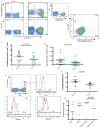
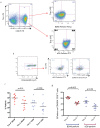
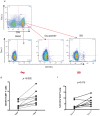
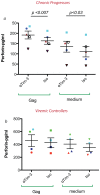
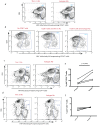
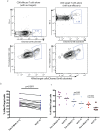
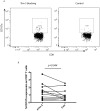
Similar articles
-
Levels of CD56+TIM-3- effector CD8 T cells distinguish HIV natural virus suppressors from patients receiving antiretroviral therapy.PLoS One. 2014 Feb 10;9(2):e88884. doi: 10.1371/journal.pone.0088884. eCollection 2014. PLoS One. 2014. PMID: 24520422 Free PMC article.
-
Tim-3 expression defines a novel population of dysfunctional T cells with highly elevated frequencies in progressive HIV-1 infection.J Exp Med. 2008 Nov 24;205(12):2763-79. doi: 10.1084/jem.20081398. Epub 2008 Nov 10. J Exp Med. 2008. PMID: 19001139 Free PMC article.
-
The presence of cytotoxic CD4 and exhausted-like CD8+ T-cells is a signature of active tuberculosis.Biochim Biophys Acta Mol Basis Dis. 2024 Aug;1870(6):167219. doi: 10.1016/j.bbadis.2024.167219. Epub 2024 May 10. Biochim Biophys Acta Mol Basis Dis. 2024. PMID: 38734321
-
CD8+ T-cells: function and response to HIV infection.Curr HIV Res. 2004 Jan;2(1):23-37. doi: 10.2174/1570162043485077. Curr HIV Res. 2004. PMID: 15053338 Review.
-
Regulation of CD8+ T-cell cytotoxicity in HIV-1 infection.Cell Immunol. 2015 Nov-Dec;298(1-2):126-33. doi: 10.1016/j.cellimm.2015.10.009. Epub 2015 Oct 24. Cell Immunol. 2015. PMID: 26520669 Review.
Cited by
-
The Role of Immunomodulatory Receptors in the Pathogenesis of HIV Infection: A Therapeutic Opportunity for HIV Cure?Front Immunol. 2020 Jul 2;11:1223. doi: 10.3389/fimmu.2020.01223. eCollection 2020. Front Immunol. 2020. PMID: 32714317 Free PMC article. Review.
-
Tobacco smoke and morphine alter peripheral and CNS inflammation following HIV infection in a humanized mouse model.Sci Rep. 2020 Aug 19;10(1):13977. doi: 10.1038/s41598-020-70374-7. Sci Rep. 2020. PMID: 32814790 Free PMC article.
-
Inhibitory Receptor Expression Depends More Dominantly on Differentiation and Activation than "Exhaustion" of Human CD8 T Cells.Front Immunol. 2013 Dec 19;4:455. doi: 10.3389/fimmu.2013.00455. eCollection 2013. Front Immunol. 2013. PMID: 24391639 Free PMC article.
-
Development and Characterization of a Nanobody against Human T-Cell Immunoglobulin and Mucin-3.Comput Math Methods Med. 2022 Jun 11;2022:2929605. doi: 10.1155/2022/2929605. eCollection 2022. Comput Math Methods Med. 2022. Retraction in: Comput Math Methods Med. 2023 Sep 27;2023:9803219. doi: 10.1155/2023/9803219. PMID: 35726228 Free PMC article. Retracted.
-
Immune Protection of SIV Challenge by PD-1 Blockade During Vaccination in Rhesus Monkeys.Front Immunol. 2018 Oct 23;9:2415. doi: 10.3389/fimmu.2018.02415. eCollection 2018. Front Immunol. 2018. PMID: 30405615 Free PMC article.
References
-
- Heinkelein M, Schneider-Schaulies J, Walker BD, Jassoy C. Inhibition of cytotoxicity and cytokine release of CD8+ HIV-specific cytotoxic T lymphocytes by pentoxifylline. J Acquir Immune Defic Syndr Hum Retrovirol. 1995;10:417–424. - PubMed
-
- Shacklett BL, Cox CA, Quigley MF, Kreis C, Stollman NH, et al. Abundant expression of granzyme A, but not perforin, in granules of CD8+ T cells in GALT: implications for immune control of HIV-1 infection. J Immunol. 2004;173:641–648. - PubMed
-
- Trimble LA, Lieberman J. Circulating CD8 T lymphocytes in human immunodeficiency virus-infected individuals have impaired function and downmodulate CD3 zeta, the signaling chain of the T-cell receptor complex. Blood. 1998;91:585–594. - PubMed
-
- Andersson J, Behbahani H, Lieberman J, Connick E, Landay A, et al. Perforin is not co-expressed with granzyme A within cytotoxic granules in CD8 T lymphocytes present in lymphoid tissue during chronic HIV infection. AIDS. 1999;13:1295–1303. - PubMed
Publication types
MeSH terms
Substances
Grants and funding
LinkOut - more resources
Full Text Sources
Other Literature Sources
Medical
Research Materials

